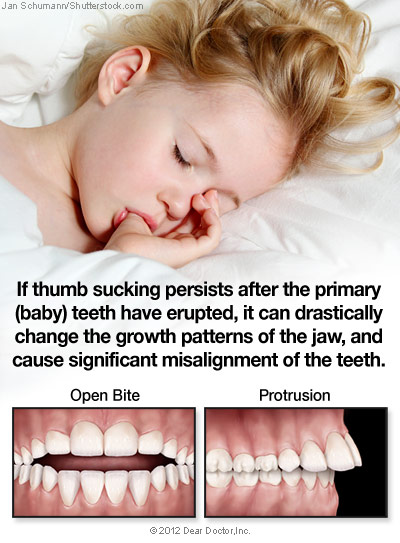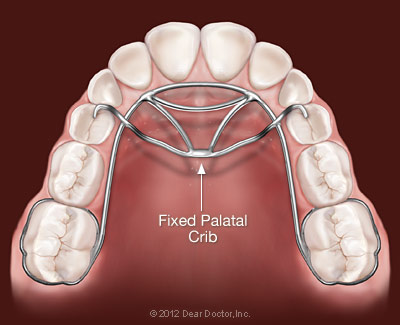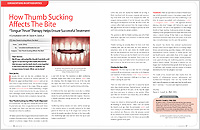
Is there any image that illustrates the comforts of babyhood better than a sleepy infant sucking its thumb? Ultrasound pictures have shown, to the joy of many prospective parents, that this behavior can even occur in the womb. The thumb- or finger-sucking habit seems to relax and comfort toddlers too, and it's perfectly natural. But as a child grows, there comes a point where this habit isn't just socially awkward — it may also be harmful to his or her oral health.
In most children, thumb sucking stops on its own between the ages of two and four years. But if the practice persists after the primary (baby) teeth have erupted, it can drastically change the growth patterns of the jaw, and cause significant misalignment of the teeth. It may be hard to believe that such a benign habit can actually move teeth and bone — but there are a number reasons why this occurs.
Children's jaws, rich in blood supply and growing rapidly, are relatively soft and flexible — especially in kids under the age of eight. So it really isn't hard for the constant pressure of a thumb or finger to deform the soft bone around the upper and lower front teeth. Children who are particularly vigorous thumb suckers are even more likely to change the growth patterns of the teeth and jaws.
If the thumb sucking habit persists, it can result in the upper front teeth flaring out and the lower ones moving back and inward. It can also hold back the growth of the lower jaw, while causing the upper jaw to be thrust forward. This can result in misalignment of the teeth, an anterior open bite (where the front teeth fail to close together), collapse of the upper jaw causing crossbite, or other problems. That's why it is important to stop the behavior at an appropriate time, before damage occurs.
Controlling Thumb or Finger Sucking
Like many potentially harmful behavior patterns, thumb sucking can be a difficult habit to break. Through the years, parents have tried a variety of home remedies, such as having the child wear gloves, coating the digits with a bitter-tasting substance — and even reasoning with their toddlers. Sometimes it works — but in other cases, the allure of thumb sucking proves very difficult to control.

If your child has a thumb or finger sucking habit that has persisted past the age of three, and you've been unable to tame it, then it may be time for you to visit our office. We will consider treating your child with a “habit appliance” such as a fixed palatal crib or a removable device. This crib isn't for sleeping — it's a small metal appliance worn inside the mouth, attached to the upper teeth.
How does it work? The semicircular wires of a palatal crib keep the thumb or finger from touching the gums behind the front teeth. Simply preventing this contact seems to take all the enjoyment away from the thumb sucking habit — and without that pleasurable feedback, a child has no reason to continue the behavior. In fact, the device is often successful the first day it's worn.
Getting and Using a Habit Appliance
If your child could benefit from a habit appliance, the first step is to get a thorough examination, which may include taking X-rays, photographs and dental impressions. If it's recommended, a crib will then be custom-fabricated to fit your child's mouth, and placed at a subsequent appointment. Afterwards, your child will be periodically monitored until the appliance is removed — typically, a period of months.
Although wearing the crib isn't painful, your child may experience some soreness in the upper back teeth for a few hours after it's first installed. He or she may also have a little trouble falling asleep for a day or two afterward. Plenty of extra attention and TLC are usually all that's needed to make everything all right. While the appliance is being worn, it's best to avoid chewing gum and eating hard, sticky food that might cause it to come loose.
A Word About Tongue Thrusting
Like thumb sucking, tongue thrusting is a normal behavioral pattern in young children. It's actually part of the natural infantile swallowing pattern, which will normally change on its own — by the age of six, in most children. If the pattern doesn't change, however, it can lead to problems similar to those caused by thumb sucking: namely, problems with tooth alignment and skeletal development. Fortunately, this problem can be successfully treated with a habit appliance that's very similar to a fixed palatal crib.
Related Articles

How Thumb Sucking Affects The Bite
Thumb sucking can actually block the front teeth from erupting fully and can also push the teeth forward — sometimes more on the side where the thumb rested. How far out of position the teeth end up will depend on the number of hours per day the thumb was in the child's mouth and how much pressure was applied. When the pressure exerted by the thumb in the mouth is particularly strong and occurs over a long period of time, the forces can potentially influence growth of the jaws... Read Article